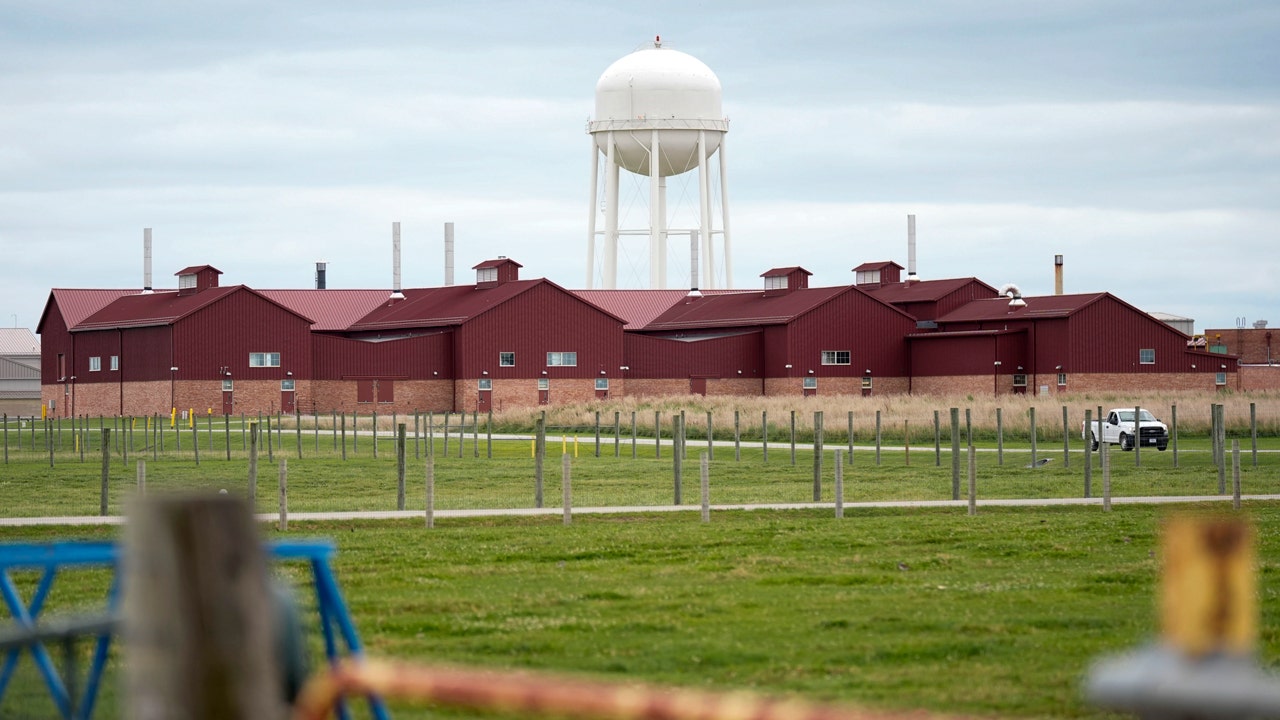Health
How scientists in Iowa are working to stop the bird flu outbreak infecting US dairy cows

CDC issues alert over bird flu case
Fox News medical contributor Dr. Marc Siegel on what to know about bird flu and why it is important to not look directly at the solar eclipse without proper glasses
- The U.S. Department of Agriculture is studying pigs, cows and other animals at Iowa’s National Animal Disease Center in an attempt to stop the burgeoning bird flu outbreak.
- Scientists were surprised to suddenly discover infections in the udders and milk of dairy cows this year, as the influenza virus is typically considered a respiratory disease.
- Bird flu was first identified in 1959. Since then, it has been detected in a growing number of animals ranging from dogs and cats to sea lions and polar bears, and now dairy cows.
At first glance, it looks like an unassuming farm. Cows are scattered across fenced-in fields. A milking barn sits in the distance with a tractor parked alongside. But the people who work there are not farmers, and other buildings look more like what you’d find at a modern university than in a cow pasture.
Welcome to the National Animal Disease Center, a government research facility in Iowa where 43 scientists work with pigs, cows and other animals, pushing to solve the bird flu outbreak currently spreading through U.S. animals — and develop ways to stop it.
Particularly important is the testing of a cow vaccine designed to stop the continued spread of the virus — thereby, hopefully, reducing the risk that it will someday become a widespread disease in people.
HEALTH EXPERTS RAISE CONCERN OVER THE DISPOSAL OF INFECTED POULTRY BIRDS AS AVIAN FLU SPREADS
The U.S. Department of Agriculture facility opened in 1961 in Ames, a college town about 45 minutes north of Des Moines. The center is located on a pastoral, 523-acre site a couple of miles east of Ames’ low-slung downtown.
It’s a quiet place with a rich history. Through the years, researchers there developed vaccines against various diseases that endanger pigs and cattle, including hog cholera and brucellosis. And work there during the H1N1 flu pandemic in 2009 — known at the time as “swine flu” — proved the virus was confined to the respiratory tract of pigs and that pork was safe to eat.
The center has the unusual resources and experience to do that kind of work, said Richard Webby, a prominent flu researcher at St. Jude Children’s Research Hospital in Memphis.
A large animal containment building is seen on the campus of the U.S. Department of Agriculture’s National Animal Disease Center research facility in Ames, Iowa, on Aug. 6, 2024. (AP Photo/Charlie Neibergall)
“That’s not a capacity that many places in the U.S. have,” said Webby, who has been collaborating with the Ames facility on the cow vaccine work.
The campus has 93 buildings, including a high-containment laboratory building whose exterior is reminiscent of a modern megachurch but inside features a series of compartmentalized corridors and rooms, some containing infected animals. That’s where scientists work with more dangerous germs, including the H5N1 bird flu. There’s also a building with three floors of offices that houses animal disease researchers as well as a testing center that is a “for animals” version of the CDC labs in Atlanta that identify rare (and sometimes scary) new human infections.
About 660 people work at the campus — roughly a third of them assigned to the animal disease center, which has a $38 million annual budget. They were already busy with a wide range of projects but grew even busier this year after the H5N1 bird flu unexpectedly jumped into U.S. dairy cows.
“It’s just amazing how people just dig down and make it work,” said Mark Ackermann, the center’s director.
The virus was first identified in 1959 and grew into a widespread and highly lethal menace to migratory birds and domesticated poultry. Meanwhile, the virus evolved, and in the past few years has been detected in a growing number of animals ranging from dogs and cats to sea lions and polar bears.
Despite the spread in different animals, scientists were still surprised this year when infections were suddenly detected in cows — specifically, in the udders and milk of dairy cows. It’s not unusual for bacteria to cause udder infections, but a flu virus?
“Typically we think of influenza as being a respiratory disease,” said Kaitlyn Sarlo Davila, a researcher at the Ames facility.
Much of the research on the disease has been conducted at a USDA poultry research center in Athens, Georgia, but the appearance of the virus in cows pulled the Ames center into the mix.
Amy Baker, a researcher who has won awards for her research on flu in pigs, is now testing a vaccine for cows. Preliminary results are expected soon, she said.
USDA spokesperson Shilo Weir called the work promising but early in development. There is not yet an approved bird flu vaccine being used at U.S. poultry farms, and Weir said that while poultry vaccines are being pursued, any such strategy would be challenging and would not be guaranteed to eliminate the virus.
Baker and other researchers also have been working on studies in which they try to see how the virus spreads between cows. That work is going on in the high-containment building, where scientists and animal caretakers don specialized respirators and other protective equipment.
The research exposed four yearling heifers to a virus-carrying mist and then squirted the virus into the teats and udders of two lactating cows. The first four cows got infected but had few symptoms. The second two got sicker — suffering diminished appetite, a drop in milk production and producing thick, yellowish milk.
The conclusion that the virus mainly spread through exposure to milk containing high levels of the virus — which could then spread through shared milking equipment or other means — was consistent with what health investigators understood to be going on. But it was important to do the work because it has sometimes been difficult to get complete information from dairy farms, Webby said.
“At best we had some good hunches about how the virus was circulating, but we didn’t really know,” he added.
USDA scientists are doing additional work, checking the blood of calves that drank raw milk for signs of infection.
A study conducted by the Iowa center and several universities concluded that the virus was likely circulating for months before it was officially reported in Texas in March.
The study also noted a new and rare combination of genes in the bird flu virus that spilled over into the cows, and researchers are sorting out whether that enabled it to spread to cows, or among cows, said Tavis Anderson, who helped lead the work.
Either way, the researchers in Ames expect to be busy for years.
“Do they (cows) have their own unique influenzas? Can it go from a cow back into wild birds? Can it go from a cow into a human? Cow into a pig?” Anderson added. “Understanding those dynamics, I think, is the outstanding research question — or one of them.”

Health
Words and game of Scrabble keep married couple in wedded bliss for decades

A married couple who have long enjoyed the game of Scrabble both together and separately before they even met are never at a loss for words — and attribute their wedded bliss in part to their love of the nostalgic game.
They’re still playing in tournaments built around the game decades after they began doing so.
Graham Harding and his wife Helen Harding, both in their 60s, have been married for over 20 years.
WATCHING GAME SHOWS LIKE ‘JEOPARDY!’ AND ‘WHEEL OF FORTUNE’ CAN BOOST COGNITIVE HEALTH, SAY EXPERTS
They met in the 1990s at Scrabble tournaments, as news agency SWNS reported.
But it was a “special match” in 2000 that brought the couple together — and has kept them together now.
Graham and Helen Harding on their wedding day. They’ve been playing in Scrabble tournaments for some 30 years. (Courtesy Graham and Helen Harding via SWNS)
Graham Harding is from the East Berkshire Scrabble Club, while his wife Helen is from the Leicester Scrabble Club in the U.K.
They have been taking part in the UK Open Scrabble Championship in Reading this week.
“The more words you know, the more ammunition you’ve got.”
“Scrabble is all about having a good vocabulary,” said Graham Harding, SWNS noted.
7 HEALTHY LIFESTYLE CHANGES THAT COULD HELP REDUCE RISK OF DEPRESSION, SAYS STUDY: ‘ENORMOUS BENEFITS’
“But it is a Scrabble vocabulary — not necessarily everyday English.”
Added Helen Harding, “The more words you know, the more ammunition you’ve got.”

Graham and Helen Harding’s wedding cake. They bonded over their love of Scrabble – and are still playing in tournaments together. (Courtesy Graham and Helen Harding via SWNS)
The couple said they were “vague acquaintances” for about five years after they first met.
Then they got together after a special match in Swindon.
CLICK HERE TO SIGN UP FOR OUR HEALTH NEWSLETTER
They maintained a long-distance relationship before they got married in 2004.
The couple even brought their Scrabble board to their wedding.

The couple likely have played thousands of games between them. (Courtesy Graham and Helen Harding via SWNS)
It featured a message with Scrabble pieces that said, “Congratulations on your wedding day” — while their wedding cake said, in Scrabble letters, “Helen and Graham.”
For more Health articles, visit www.foxnews.com/health
They each took up the hobby early in life well before they met each other.
The tournament that’s been taking place this week is the first since the COVID pandemic after a five-year break — and the couple has played some two dozen games in it as of Friday, SWNS reported.
Health
Deep sleep can keep two big health problems at bay, new studies suggest

It might be worth working a little bit harder to get that much-desired, but often elusive, good night’s sleep.
Deep sleep clears the mind of waste just as a “dishwasher” cleans dirty plates and glasses, just-published research suggests — and there’s more.
The findings also offer insights into how sleeping pills may disrupt the “brainwashing” system — potentially affecting cognitive function for people over the long run.
ANOTHER REASON TO GET MORE SLEEP AND THIS ONE MIGHT SURPRISE YOU
Study senior author professor Maiken Nedergaard of the University of Rochester and the University of Copenhagen said norepinephrine (a neurotransmitter and hormone) triggers blood vessels to contract — generating slow pulsations that create a rhythmic flow in the surrounding fluid to carry away waste, news agency SWNS noted.
Said Nedergaard, “It’s like turning on the dishwasher before you go to bed and waking up with a clean brain. . . . We’re essentially asking what drives this process and trying to define restorative sleep based on” this “glymphatic clearance.”
“It’s like turning on the dishwasher before you go to bed and waking up with a clean brain.” (iStock)
The brain has a built-in waste removal process – the glymphatic system – that circulates fluid in the brain and spinal cord to clear out waste, according to the scientists.
The process helps remove toxic proteins that form sticky plaques linked to neurological disorders, such as Alzheimer’s disease.
But the scientists indicated that what drives the system was unclear until now, according to the study.
Is all sleep created equal? The researchers wanted to find out.
To find clues, Nedergaard and her team looked into what happens in mice when their brains sleep, as SWNS reported of the study. The team focused on the relationship between norepinephrine and blood flow during deep sleep.
TRUMP’S DAYLIGHT SAVING PLAN AND SLEEP: WHAT YOU MUST KNOW
They found that norepinephrine waves correlate to variations in brain blood volume — suggesting that norepinephrine triggers a rhythmic pulsation in the blood vessels. The researchers then compared the changes in blood volume to brain fluid flow.
The brain fluid flow fluctuates in correspondence to blood volume changes, suggesting the vessels act as pumps to propel the surrounding brain fluid to flush out waste.

During deep sleep, toxic proteins that form sticky plaques linked to neurological disorders such as Alzheimer’s disease are removed, scientists say in a new study. (iStock)
Natalie Hauglund of the University of Copenhagen and the University of Oxford, the study’s lead author, said, “You can view norepinephrine as [the] conductor of an orchestra.”
She added, “There’s a harmony in the constriction and dilation of the arteries, which then drives the cerebrospinal fluid through the brain to remove the waste products.”
‘I CAN’T SLEEP BECAUSE OF RACING THOUGHTS AT NIGHT — HOW CAN I STOP THEM?’: ASK A DOCTOR
Hauglund said she wanted to understand whether all sleep is created equal.
To find out, the research team administered zolpidem, a common drug to aid sleep, to mice.
“If people aren’t getting the full benefits of sleep, they should be aware of that, so they can make informed decisions.”
They found that the norepinephrine waves during deep sleep were 50% lower in zolpidem-treated mice than in naturally sleeping mice.
Although the zolpidem-treated mice fell asleep more quickly — fluid transport into the brain dropped more than 30%, as SWNS reported.

Two new studies indicate the importance of getting a good night’s sleep — with one study saying a lack of sleep may be sabotaging the brain’s ability to keep intrusive thoughts at bay. (iStock)
The researchers say their findings, published in the journal Cell, suggest that the sleeping aid may disrupt the norepinephrine-driven waste clearance during sleep.
Hauglund said, “More and more people are using sleep medication, and it’s really important to know if that’s healthy sleep. If people aren’t getting the full benefits of sleep, they should be aware of that, so they can make informed decisions.”
CLICK HERE TO SIGN UP FOR OUR HEALTH NEWSLETTER
The research team said the findings likely apply to humans, who also have a glymphatic system, although it requires further testing.
Nedergaard added, “Now we know norepinephrine is driving the cleaning of the brain, we may figure out how to get people a long and restorative sleep.”
For more Health articles, visit www.foxnews.com/health
Meanwhile, a lack of sleep may be doing more damage than just making people groggy.
It could be sabotaging the brain’s ability to keep intrusive thoughts at bay.

Anyone who suffers from sleep deprivation may find that the brain’s defense against unwanted memories is weakened, say experts. (iStock)
Another new study, this one published in the Proceedings of the National Academy of Sciences, found that sleep deprivation weakens the brain’s defense against unwanted memories, allowing them to flood the mind, according to the New York Post.
“We show that sleep deprivation disrupts prefrontal inhibition of memory retrieval, and that the overnight restoration of this inhibitory mechanism is associated with time spent in rapid eye movement (REM) sleep,” the scientists said.
Health
How Kathy Bates Lost 100 Lbs—Plus Her Tips for Sustainable Weight Loss

Sign Up
Create a free account to access exclusive content, play games, solve puzzles, test your pop-culture knowledge and receive special offers.
Already have an account? Login
Use left and right arrow keys to navigate between menu items.
Use escape to exit the menu.
-

 Politics1 week ago
Politics1 week agoNew Orleans attacker had 'remote detonator' for explosives in French Quarter, Biden says
-

 Politics1 week ago
Politics1 week agoCarter's judicial picks reshaped the federal bench across the country
-

 Politics1 week ago
Politics1 week agoWho Are the Recipients of the Presidential Medal of Freedom?
-

 Health6 days ago
Health6 days agoOzempic ‘microdosing’ is the new weight-loss trend: Should you try it?
-

 World1 week ago
World1 week agoSouth Korea extends Boeing 737-800 inspections as Jeju Air wreckage lifted
-
/cdn.vox-cdn.com/uploads/chorus_asset/file/25822586/STK169_ZUCKERBERG_MAGA_STKS491_CVIRGINIA_A.jpg)
/cdn.vox-cdn.com/uploads/chorus_asset/file/25822586/STK169_ZUCKERBERG_MAGA_STKS491_CVIRGINIA_A.jpg) Technology3 days ago
Technology3 days agoMeta is highlighting a splintering global approach to online speech
-

 World1 week ago
World1 week agoWeather warnings as freezing temperatures hit United Kingdom
-

 News1 week ago
News1 week agoSeeking to heal the country, Jimmy Carter pardoned men who evaded the Vietnam War draft

/cdn.vox-cdn.com/uploads/chorus_asset/file/23935558/acastro_STK103__01.jpg)











